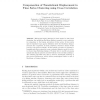Free Online Productivity Tools
i2Speak
i2Symbol
i2OCR
iTex2Img
iWeb2Print
iWeb2Shot
i2Type
iPdf2Split
iPdf2Merge
i2Bopomofo
i2Arabic
i2Style
i2Image
i2PDF
iLatex2Rtf
Sci2ools
IDA
2009
Springer
2009
Springer
Compensation of Translational Displacement in Time Series Clustering Using Cross Correlation
Although k-means clustering is often applied to time series clustering, the underlying Euclidean distance measure is very restrictive in comparison to the human perception of time series. A time series and its translated copy appear dissimilar under the Euclidean distance (because the comparison is made pointwise), whereas a human would perceive both series as similar. As the human perception is tolerant to translational effects, using the cross correlation distance would be a better choice than Euclidean distance. We show how to modify a k-means variant such that it operates correctly with the cross correlation distance. The resulting algorithm may also be used for meaningful clustering of time series subsequences, which delivers meaningless results in case of Euclidean or Pearson distance.
| Added | 25 Jul 2010 |
| Updated | 25 Jul 2010 |
| Type | Conference |
| Year | 2009 |
| Where | IDA |
| Authors | Frank Höppner, Frank Klawonn |
Comments (0)

